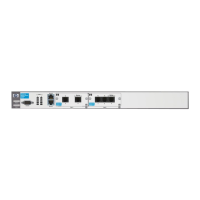B-9
Appendix B: Glossary
CDMA Code Division Multiple Access. A digital cellular technology that uses spread-
spectrum techniques. CDMA does not assign a specific frequency to each user.
Instead, every channel uses the full available spectrum, spreading the signal
over the entire available bandwidth. Multiple calls are overlaid over each other
on the channel, and each one is assigned a unique sequence code.
CEPT Conference of European Postal and Telecommunications. A standardizing
body. For more information about CEPT, see the CEPT website at http://
www.cept.org.
CEPT Hierarchy
The signal hierarchy used with E-carrier lines.
See also
E1-carrier line and E-3
carrier line.
Table G-1. CEPT signal hierarchy
Certificate See Digital Certificate.
Channelized A circuit that is created by multiplexing and demultiplexing voice and/or data
using analog or digital techniques.
CHAP Challenge Handshake Authentication Protocol. An authentication protocol
that is supported by PPP. With CHAP, the authenticator challenges the peer.
The peer creates a hash value from its pre-shared password and a string of
text. The authenticator also creates a hash value. The authenticator compares
the hash values. If they match, authentication succeeds, and the link is
established. For more information about CHAP, see RFC 2759 (at http://
www.ietf.org/rfc/rfc2759.txt). See also PAP and PPP.
CIDR Classless Inter-Domain Routing. An IP addressing scheme that replaces the
older system based on A, B, and C classful addresses. With CIDR, a single IP
address can be used to designate many unique IP addresses. A CIDR IP address
resembles a normal IP address except that it ends with a slash followed by a
number called the IP network prefix, which specifies how many addresses are
Physical
carrier
DSD EO multiple E1 multiple Transmission rate
— E0 1 — 64 Kbps
E1 E1 32 — 2.048 Mbps
E2 E2 128 4 8.448 Mbps
E3 E3 512 16 34.368 Mbps
E4 E4 2048 64 139.264 Mbps
E5 E5 8192 256 565.148 Mbps

